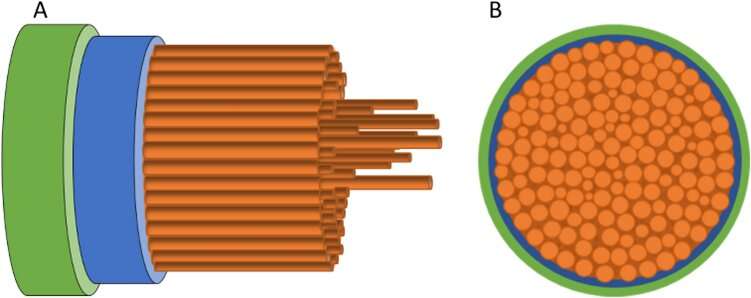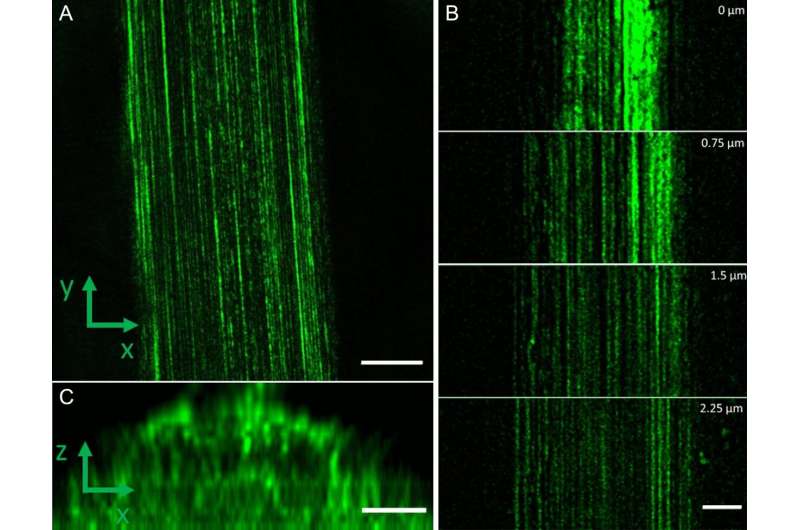This article has been reviewed according to Science X's editorial process and policies. Editors have highlighted the following attributes while ensuring the content's credibility:
fact-checked
peer-reviewed publication
trusted source
proofread
New details about the strongest spider silk in the world

Many researchers dream of deciphering the amazing ability of spiders to create super strong, super light, and super flexible silk threads—but so far, no one has been able to replicate the spiders' work.
Should it one day become possible to produce a synthetic material with the same properties, a whole new world of possibilities may open: Artificial spider silk could replace materials like Kevlar, polyester, and carbon fiber in industries and be used, for example, to make lightweight and flexible bulletproof vests.
Postdoc and biophysicist Irina Iachina from the Department of Biochemistry and Molecular Biology, University of Southern Denmark (SDU), is involved in this race to uncover the recipe for super silk. She has been fascinated by spider silk since her time as a master's student at SDU, and currently, she is researching the topic at the Massachusetts Institute of Technology in Boston with support from the Villum Foundation.
As part of her research, she is collaborating with associate professor and biophysicist Jonathan Brewer at SDU, who is an expert in using various types of microscopes to peer into biological structures.
Together, they have now, for the first time, studied the internal parts of spider silk using an optical microscope without cutting or opening the silk in any way. This work has now been published in the journals Scientific Reports and Scanning.
"We have used several advanced microscopy techniques, and we have also developed a new kind of optical microscope that allows us to look all the way into a piece of fiber and see what's inside," explains Jonathan Brewer.
So far, spider silk has been analyzed using various techniques, all of which have provided new insights. However, there have also been drawbacks to these techniques, as Jonathan Brewer points out, since they often require cutting the silk thread (also called fiber) open to obtain a cross-section for microscopic examination or freezing the samples, which can alter the structure of the silk fibers.
"We wanted to study pure and unmanipulated fibers that have not been cut, frozen, or manipulated in any way," says Irina Iachina.

For this purpose, the research duo used less invasive techniques such as Coherent Anti-Stokes Raman Scattering, Confocal Microscopy, Ultra-resolution Confocal Reflection Fluorescence Depletion Microscopy, Scanning Helium Ion Microscopy, and Helium Ion Sputtering.
The different studies revealed that the spider's silk fiber consists of at least two outer layers of lipids, i.e., fats. Behind them, inside the fiber, there are numerous so called fibrils running in a straight, tightly packed side-by-side arrangement (see illustration). The fibrils have a diameter ranging between 100 and 150, which is below the limit of what can be measured with a regular light microscope.
"They are not twisted, which one might have imagined, so now we know that there is no need to twist them when attempting to create synthetic spider silk," says Irina Iachina.
Iachina and Brewer work with silk fibers from the golden orb-web spider, Nephila Madagascariensis, which produces two different types of silk: One, called MAS (Major Ampullate Silk fibers), is used to construct the spider's web, and it is also the silk the spider uses to hang on. Irina Iachina refers to it as the spider's lifeline; it is very strong and has a diameter of approximately 10 micrometers.
The other, called MiS (Minor Ampullate Silk fibers), serves as an auxiliary material for the construction. It is more elastic and typically has a diameter of 5 micrometers.
According to the duo's analysis, the MAS silk contains fibrils with a diameter of approximately 145 nanometers. For MiS, it is approximately 116 nanometers. Each fibril is made up of proteins, and several different proteins are involved. These proteins are produced by the spider when it creates its silk fibers.
Understanding how they can create such strong fibers is important, but the fibers are also challenging to produce. Therefore, researchers in this field often rely on spiders to produce the silk for them.
Alternatively, they can turn to computational methods, which is what Irina Iachina is currently working on at MIT:
"Right now, I am doing computer simulations of how proteins transform into silk. The goal is, of course, to learn how to produce artificial spider silk, but I am also interested in contributing to a greater understanding of the world around us," she says.
More information: Irina Iachina et al, Nanoscale imaging of major and minor ampullate silk from the orb-web spider Nephila Madagascariensis, Scientific Reports (2023). DOI: 10.1038/s41598-023-33839-z
Irina Iachina et al, Helium Ion Microscopy and Sectioning of Spider Silk, Scanning (2023). DOI: 10.1155/2023/2936788
Journal information: Scientific Reports
Provided by University of Southern Denmark




















